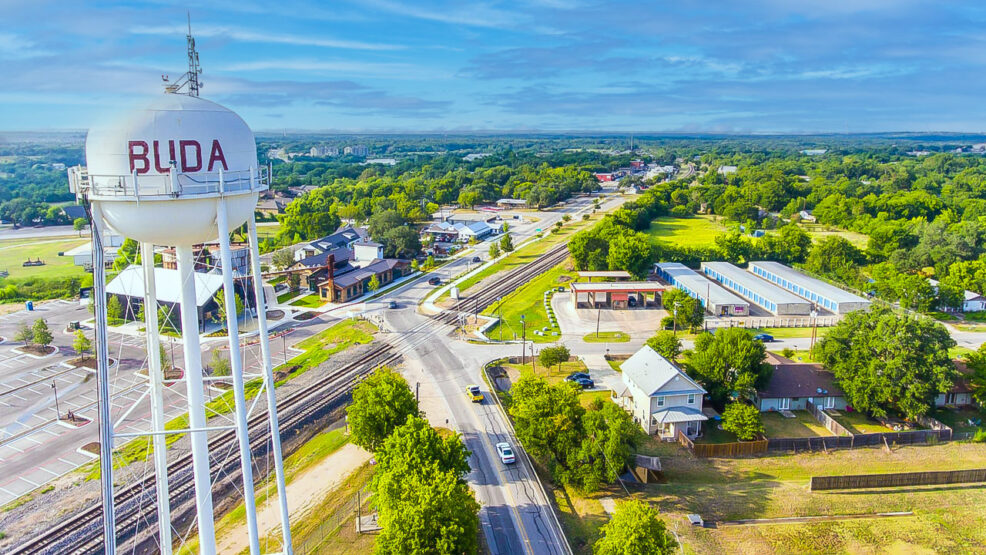Key Takeaways
-
Pros and Cons of Living in Buda: As a southern suburb of Austin, Buda offers affordable housing and a quieter lifestyle but faces challenges like heavy traffic on I-35 and Route 1626 to Mopac.
-
Rapid Population Growth and Infrastructure Lag: Buda’s rapid population growth has led to significant road congestion. The town’s infrastructure development often lags behind new housing developments, causing temporary inconveniences for residents.
-
Affordable Housing Market: Buda is known for its affordable housing options compared to Austin. With homes priced under $300,000 in neighborhoods like Green Meadows and new developments by builders such as D.R. Horton in Prairie Lakes, Buda provides a cost-effective alternative for homebuyers.
-
Rich Historical and Cultural Heritage: Buda has a rich historical and cultural heritage, evident in its downtown historical area. The town’s name, derived from the Spanish word “viuda” (widow), reflects its unique history, and the presence of historical markers and preserved buildings adds to its charm.
- Community Amenities and Quality of Life: Buda offers various community amenities, including parks, skate parks, and a new municipal building with a public library. Being part of the Hays Consolidated Independent School District and having numerous recreational options contribute to a high quality of life for residents.
Nestled just 20 minutes south of Austin, Buda, Texas, is an emerging suburb that offers a unique blend of affordability, history, and community. With its rapid population growth, expanding infrastructure, and a plethora of amenities, Buda is becoming an attractive destination for home buyers seeking proximity to Austin without the hefty price tag. This guide will explore the ins and outs of buying a house in Buda, highlighting key neighborhoods, housing options, and the town’s charming historical and cultural backdrop.
Navigating the Home Buying Process in Buda
Buying a house in Buda involves several steps, beginning with understanding the local real estate market. With its proximity to Austin, Buda offers a more affordable alternative for home buyers. Whether you’re interested in buying a home in Buda’s established neighborhoods like Green Meadows or new developments by builders such as D.R. Horton in Prairie Lakes, there’s something for everyone. It’s essential to work with a local real estate agent familiar with Buda’s market to find the best deals.
The process of buying a house in Buda also includes considering the town’s growth and infrastructure plans. Buda’s rapid population increase has led to road congestion, particularly along I-35 and Route 1626 to Mopac. Prospective buyers should factor in commute times and traffic patterns when choosing a location within Buda. Despite these challenges, the town’s ongoing development projects promise improved infrastructure in the future.
Affordable Housing Options in Buda
One of Buda’s main attractions is its affordable housing market. Compared to Austin, where home prices are significantly higher, Buda offers homes priced under $300,000. Neighborhoods like Green Meadows provide excellent value for first-time home buyers or those looking to downsize without sacrificing proximity to Austin. This affordability makes buying a home in Buda an attractive option for many.
In addition to existing homes, Buda has numerous new construction opportunities. Developments like D.R. Horton’s Prairie Lakes offer modern amenities and various floor plans to suit different lifestyles. These new communities are perfect for those seeking the latest in home design and community planning, all while enjoying the benefits of Buda’s lower home prices.
Historical and Cultural Attractions
Buda’s rich history is evident in its downtown historical area, where buildings dating back over a century stand alongside modern shops and cafes. The town’s name, derived from the Spanish word “viuda” (widow), reflects its storied past, including the legacy of the Carrington House and its famous widows. The downtown area is a charming place to explore, with establishments like the Meridian Coffee Bar offering a blend of old-world charm and contemporary amenities.
The historical significance of Buda extends beyond its name. The town was settled by many of German descent, adding to its cultural tapestry. Historical markers and preserved buildings provide a glimpse into Buda’s past, from the days of the train station to the segregation era, highlighted by the Antioch Colony established by former slaves. This rich history adds depth to the experience of living in Buda.
Community Amenities and Parks
Buda boasts a variety of community amenities that enhance its appeal. The town’s parks, such as Historic Stagecoach Park, offer residents miles of walking trails and outdoor activities. This park, just outside of downtown, is a perfect example of Buda’s commitment to preserving its natural beauty while providing recreational spaces for its growing population.
For those interested in more active pursuits, the Jackson Tyler Norris Skate Park is a popular spot. This facility caters to the town’s youth and skateboarding enthusiasts, highlighting Buda’s investment in community amenities. These parks and recreational areas contribute to the high quality of life enjoyed by Buda residents.
The Role of Hays Consolidated Independent School District
Education is a vital consideration for families moving to Buda. The town is part of the Hays Consolidated Independent School District, which serves over 21,000 students across 26 schools. This district is known for its commitment to academic excellence and offers a range of programs to support student growth and development.
Parents looking to buy a house in Buda can be confident in the quality of education their children will receive. The district’s schools are equipped with modern facilities and staffed by dedicated educators, ensuring a supportive learning environment. This focus on education makes Buda an attractive choice for families.
Traffic and Commuting Considerations
One of the primary challenges of living in Buda is navigating the traffic, especially during rush hour. The town’s main access route to Austin, I-35, is notorious for congestion. Alternative routes like 1626 to Mopac also experience heavy traffic, making commuting a significant consideration for prospective home buyers.
Despite these traffic issues, many residents find the trade-off worth it for the lower cost of living and quieter suburban lifestyle. Understanding the local traffic patterns and planning commutes carefully can help mitigate some of these challenges. Buda’s ongoing infrastructure improvements also promise to ease congestion in the future.
Exploring Buda’s Downtown Historical Area
Buda’s downtown historical area is a focal point for residents and visitors alike. This charming district, centered around the old train station, offers a glimpse into the town’s past. The area is home to various shops, antique stores, and cafes, such as the Meridian Coffee Bar, which hosts live music events and provides a cozy spot to relax.
Walking through the downtown area, you’ll see buildings that look much as they did a century ago. This blend of history and modernity creates a unique atmosphere, making downtown Buda a delightful place to spend time. The preservation of these historical buildings adds character and charm to the town.
Buda’s Unique Historical Roots
The story of Buda’s name is a testament to its unique historical roots. Derived from the Spanish word “viuda,” meaning widow, the name reflects the town’s early days and the legacy of the Carrington House. This historical narrative adds a layer of intrigue and identity to Buda, setting it apart from other Austin suburbs.
In addition to its Spanish influence, Buda has a significant German heritage. Early settlers brought their traditions and customs, contributing to the town’s cultural richness. This diverse heritage is celebrated through various historical markers and community events, preserving Buda’s unique story for future generations.
Rural Charm and Modern Convenience
Living in Buda offers a blend of rural charm and modern convenience. Despite its proximity to Austin, Buda retains a small-town feel with its wide-open spaces and slower pace of life. This rural charm is evident in the town’s landscape, dotted with farms and ranches, providing a serene backdrop for residents.
At the same time, Buda offers modern conveniences, including shopping centers, restaurants, and entertainment options. The presence of stores like Cabela’s and the lack of chain restaurants like Cracker Barrel inside the city limits highlight the town’s balance between maintaining its rural identity and accommodating growth.
Investing in Infrastructure and Community
Buda’s rapid growth has necessitated significant investment in infrastructure and community amenities. The town has channeled increased tax revenue from new residents into projects like the new municipal building and public library. These investments are aimed at enhancing the quality of life for current and future residents.
The new municipal building is a hub for community activities, providing space for public meetings, events, and a modern library. This focus on infrastructure development ensures that Buda can accommodate its growing population while maintaining a high standard of living.
Proximity to Austin: A Double-Edged Sword
Buda’s proximity to Austin is both a blessing and a curse. On the one hand, residents enjoy easy access to the vibrant cultural, economic, and social opportunities of the capital city. On the other hand, this proximity also means dealing with traffic congestion and higher demand for local services.
For those who work in Austin, the short commute from Buda is a significant advantage. However, navigating the daily traffic on I-35 can be challenging. Balancing these factors is crucial for prospective home buyers considering a move to Buda.
Conclusion
Buda, Texas, stands out as a hidden gem in the Austin suburbs, offering affordable housing, a rich historical backdrop, and a strong sense of community. While challenges like traffic and rapid population growth exist, the town’s ongoing investments in infrastructure and amenities promise a bright future. Whether you’re drawn to its historical charm, affordable home prices, or proximity to Austin, Buda presents a compelling case for those looking to buy a house in the area.
People Are Asking
- Is Buda Texas a good place to live?
- Is Buda, Texas expensive?
- Why move to Buda?
- What is the race population in Buda Texas?
- What is the crime rate in Buda, Texas?
- What is the nicest town to live in Texas?
- Is Buda TX water safe to drink?
- How much are property taxes in Buda Texas?
- What are people from Buda Texas called?
- What is Buda known for?
- Is it better to live in Buda or Pest?
- Is Buda, TX growing?
- Is Buda a suburb of Austin?
- Where is most of the black population in Texas?
- Is Buda a town or city?
Frequently Asked Questions
Q: What is the average home price in Buda, Texas?
A: The average home price in Buda is generally lower than in Austin, with many homes available for under $300,000.
Q: What are the main traffic routes in Buda?
A: The main routes are I-35 and Route 1626 to Mopac, both of which can experience heavy traffic, especially during rush hours.
Q: What is the historical significance of Buda?
A: Buda has a rich history with roots in the Spanish and German heritage, highlighted by its downtown historical area and the story of the Carrington House.
Q: Are there new construction opportunities in Buda?
A: Yes, Buda has several new developments, including D.R. Horton’s Prairie Lakes, offering modern homes at competitive prices.
Q: What amenities does Buda offer?”
A: Buda boasts parks like Historic Stagecoach Park, a new municipal building with a public library, and various shops and cafes in the downtown historical area.

